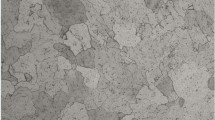Abstract
Adiabatic shear fracture in serrated chip leads to isolated segment formation in high-speed machining with the further increase of cutting speed. An energy model of adiabatic shear band is built and investigated through high-speed machining tests and chip morphology examination. A quick-stop device designed to obtain chip roots in high-speed turning is applied. The adiabatic shear fracture process on considering the induced mechanism is investigated and the multi-stage physical model of adiabatic shear fracture is proposed through chip root morphology examination. The results show that adiabatic shear fracture in high-speed machining is a periodic process from energy convergence to release. The shear band collapses and results in isolated segments formation when the energy convergence in band exceeds the saturation limit. There are possibilities of utilizing the occurrence of adiabatic shear fracture to reduce the increased rate of stress, temperature, and energy and optimize the machinability in the chip formation aspect in high-speed machining.
Similar content being viewed by others
References
Recht R (1964) Catastrophic thermoplastic shear. J Appl Mech 31:189–193
Semiatin S, Rao S (1983) Shear localization during metal cutting. Mater Sci Eng 61:185–192
Xie J, Bayoumi A, Zbib H (1998) FEA modeling and simulation of shear localized chip formation in metal cutting. Int J Mach Tool Manuf 38:1067–1087
Hou Z, Komanduri R (1997) Modeling of thermomechanical shear instability in machining. Int J Mech Sci 39:1273–1275
Guohe L, Minjie W, Chunzheng D (2009) Adiabatic shear critical condition in the high-speed cutting. J Mater Process Technol 209:1362–1367
Bai Y, Dodd B (1992) Adiabatic shear localization. Pergamon Press, Oxford
Wright T (2002) The physics and mathematics of adiabatic shear bands. Cambridge University Press, New York
Komanduri R, Schroeder T, Hazra J, Von Turkovich B, Flom D (1982) On the catastrophic shear instability in high-speed machining of an AISI 4340 steel. J Eng Ind Trans ASME 104:121–131
Gente A, Hoffmeister H, Evans C (2001) Chip formation in machining Ti6Al4V at extremely high cutting speeds. Cirp Ann-Manuf Technol 50:49–52
Barry J, Byrne G, Lennon D (2001) Observations on chip formation and acoustic emission in machining Ti6Al4V alloy. Int J Mach Tool Manuf 41:1055–1070
Hua J, Shivpuri R (2004) Prediction of chip morphology and segmentation during the machining of titanium alloys. J Mater Process Tech 150:124–133
Su G, Liu Z (2010) An experimental study on influences of material brittleness on chip morphology. Int J Adv Manuf Technol 51:87–92
Minjie W, Chunzheng D, Hongbo L (2004) Experimental Study on Adiabatic Shear Behavior in Chip Formation during Orthogonal Cutting. Chin J Mech Eng 7–10
Liyao G, Minjie W, Chunzheng D (2013) On adiabatic shear localized fracture during serrated chip evolution in high speed machining of hardened AISI 1045 steel. Int J Mech Sci 75:288–298
Liyao G, Minjie W (2013) Experimental and theoretical research on critical characteristics for adiabatic shear localization fracture in high-speed machining. Int J Adv Manuf Technol 68:1231–1240
Feng Z, Li G, Meng D (2010) A study on material dynamic plastic constitutive relationship considering hardness. Mech Autom Control Eng (MACE), 2010 Int Conf IEEE 3686–3689
Buda J (1972) New methods in the study of plastic deformation in cutting zone. Annals CIRP 21:17–18
Odeshi A, Bassim M (2009) High strain-rate fracture and failure of a high strength low alloy steel in compression. Mater Sci Eng A 525:96–101
Giovanola J (1988) Adiabatic shear banding under pure shear loading part II: fractographic and metallographic observations. Mech Mater 7:73–87
Rogers H (1983) Adiabatic shearing—general nature and material aspects, Material behavior under high stress and ultrahigh loading rates. Plenum Press, New York, pp 101–118
Author information
Authors and Affiliations
Corresponding authors
Rights and permissions
About this article
Cite this article
Gu, L., Wang, M., Chen, H. et al. Experimental study on the process of adiabatic shear fracture in isolated segment formation in high-speed machining of hardened steel. Int J Adv Manuf Technol 86, 671–679 (2016). https://doi.org/10.1007/s00170-015-8157-0
Received:
Accepted:
Published:
Issue Date:
DOI: https://doi.org/10.1007/s00170-015-8157-0



